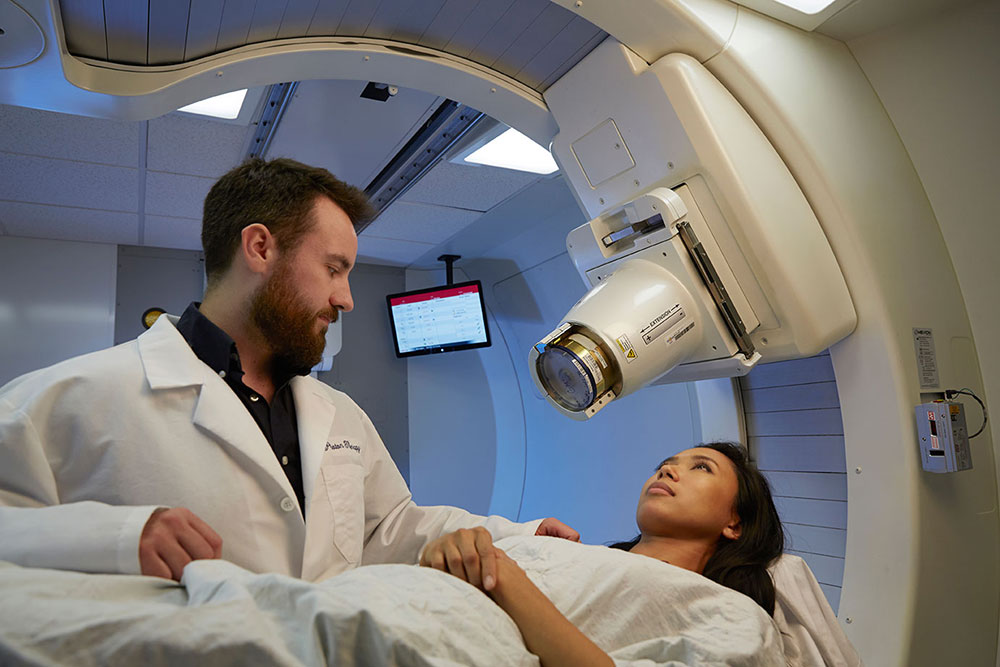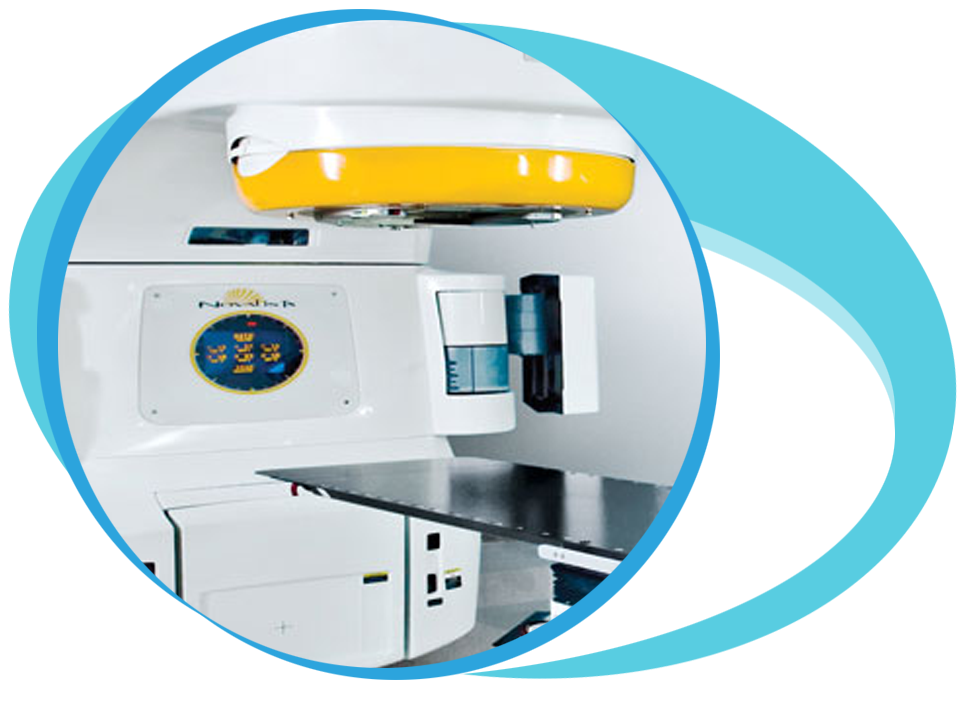Radiation Oncology in Iran Details
What is Radiation Oncology?
A medical specialty that makes use of different types of radiation for treating cancer and other diseases is known as radiation oncology.
The treatment has proved itself as a powerful weapon to fight against cancer and results in an increased number of cancer cures.
High-energy radiation is used for shrinking and destroying cancer cells.
The different types of radiation used for treating cancer include charged particles, x-rays, and gamma rays.
The delivery of this radiation can be done either from a radioactive material placed into the body close to cancer cells (Brachytherapy or internal radiation) or through a machine that is placed outside the body.
Radioactive iodine (a radioactive substance) is used in systemic radiation therapy that travels throughout the body for killing cancer cells.
The different types of radiation therapy depend on several factors, such as the followings:
- Medical condition and age of a patient
- The type of cancer
- Medical history and general health of a patient
- The location of cancer in the body
- Whether a patient also requires other types of cancer treatments
- The size of the cancer
- How far radiation needs to travel in the body
- Is cancer located close to normal tissues that are sensitive to radiation
Radiation Therapy Treatment Options
Internal radiation therapy and external radiation therapy are the two treatment options for radiation therapy.
Internal Radiation (Brachytherapy)
The delivery of this radiation is done through radiation sources that are either placed on the body or inside the body.
Different Brachytherapy techniques are used for treating cancer.
The melanoma in the eye can be treated with the help of Episcleral Brachytherapy that makes use of a source attached to the eye.
A source is placed close to a tumor either inside the body cavity or in a surgical cavity in the case of Intracavitary Brachytherapy.
The placement of a radiation source is done inside the tumor tissue in the case of Interstitial Brachytherapy.
Brachytherapy can cause less damage to the nearby normal tissues and can be given either as a high-dose or a low-dose treatment including the followings:
- The delivery tubes are attached with a robotic machine that is placed within the body guides one or more radioactive sources near or into a tumor in the case of high-dose treatment.
The removal of these sources is then done at the end of every treatment session.
More than one treatment sessions can be used in the case of high-dose treatment.
MammoSite system is the best example of a high-dose treatment that is used for treating breast cancer for those patients who have gone through breast-conserving surgery. - Continuous low-dose radiation is given to the cancer cells through a source that may take some days in the case of low-dose treatment.
External-Beam Radiation Therapy
The delivery of this therapy is primarily done in the form of photon beams.
A photon can be considered as a collection of energy and is a unit of light along with different forms of electromagnetic radiation.
The energy of a photon also may vary.
The total radiation dose is the determining factor of external beam radiation treatment.
3-Dimensional Conformal Radiation Therapy (3D-CRT) is considered as the most common type of external beam radiation.
The radiation is delivered precisely by concentrating on the affected areas by using advanced treatment machines and computer software.
External beam radiation other methods for treating cancer including the followings:
- Stereotactic Body Radiation Therapy (SBRT): Few treatment sessions are required for delivering radiation therapy by using high doses and small radiation fields.
This therapy helps in treating those tumors that lie outside the spinal cord and brain.
More than one dose is used in this therapy for treating isolated and small tumors such as lung and liver cancers.
Cyberknife radiosurgery is a type of stereotactic body radiation therapy that is considered as a non-invasive alternative to surgery.
Cyberknife can treat tumors located anywhere in the body with precise accuracy.
There is minimum damage caused to the surrounding healthy tissues and structures, including optic nerve or spinal cord. - Intensity-Modulated Radiation Therapy (IMRT): This therapy makes use of several small radiation beam-shaping devices known as collimators for delivering a single dose of radiation.
The intensity of the radiation beams can be changed at the time of treatment sessions by either moving the collimators or by keeping them stationary.
IMRT involves inverse treatment planning that delivers radiation doses to surrounding tissue and different areas of the tumor.
A high-powered computer program calculates the required number of angles and beams of the radiation treatment.
The goal is to raise the radiation dose to the different areas and thereby reducing the radiation exposure to certain sensitive areas of nearby normal tissue. - Stereotactic Radiosurgery (SRS): More than one high doses of radiation can be delivered to a tiny tumor in this method.
This method makes use of extreme accurate image-guided patient positioning and tumor targeting.
SRS is commonly used for treating brain metastases, spinal, or brain tumors from other types of cancer.
The high dose can only be delivered accurately by using other devices or a head frame for immobilizing the patient at the time of treatment.
The stereotactic radiosurgery can be best delivered by using the latest tool known as the Novalis TX.
This technology helps to focus precisely and delivers high doses of the tumor for destroying the tumor.
It also results in minimally damage to the nearby tissue and can be performed faster along with other machines.
- Tomotherapy: This is considered as a type of image guided IMRT.
The machine used by tomotherapy is a combination of external-beam radiation therapy and a CT imaging scanner machine.
This tomotherapy machine can be easily rotated around the patient and delivers radiation for both treatment and imaging.
The precise treatment can be given as this machine captures CT images of a patient just before the beginning of the treatment. - Proton Therapy: Both Photon beams and proton beams can deliver external beam radiation therapy.
The main difference between the two is terms of the deposition of energy in the living tissue.
High doses of radiation can be delivered to a tumor by using protons that may help in reducing the exposure of normal tissue to radiation. - Image-Guided Radiation Therapy (IGRT): Several imaging scans such as PET, CT, or MRI are performed at the time of treatment.
These imaging tests help to recognize changes in the location and size of a tumor.
It also provides proper adjustment of the planned radiation dose during treatment.
The accuracy of radiation treatment can be increased by providing continuous imaging, and it may also decrease the amount of total radiation dose to normal tissue.
Systemic Radiation Therapy
A patient can either receive or swallow a radioactive substance that includes a radioactive substance bound to a monoclonal antibody or radioactive iodine.
Different types of thyroid cancer can be treated with the help of radioactive iodine (a type of systemic radiation).
A monoclonal antibody targets the radioactive substance in systemic radiation therapy.
The radioactive substance is then attached to the antibody that travels from the blood and finally destroys the cancer cells.










